Amazing!!
The strategic and spiritual fronts that preceded the Yom Kippur War
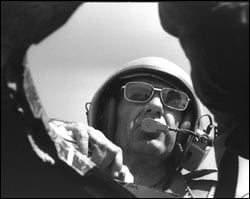 |
| A tank commander in the turret of his vehicle in Sinai Desert in October, 1973. (Photo: Shmuel Gonen Gorodish/GPO) |
"The Syrians are in a pre-jump-off position for war," Jordan's King Hussein told Israeli Prime Minister Golda Meir in his signature cryptic manner.
It was September 25, 1973, a few days before the Jewish New Year, and the Jordanian royal helicopter had secretly landed near Tel Aviv. The king had long maintained connections with Israeli prime ministers in order to keep out of armed conflicts in the region.
This was not the first warning the Israelis had received of an oncoming attack by the Syrians, who were by that time deploying troops to the border with Israelnear the Golan Heights. Threats had been coming for a long time, almost two years, with many false alarms.
As millions prayed in synagogues, the Egyptian and Syrian armies surprised the Israelis with attacks on two fronts. But one person in Brooklyn was preparing for months already...Israeli intelligence said that the Syrians would not attack without the assistance of the Egyptians. It added that at that time it seemed like the Egyptians were not ready for war—they had just received Soviet scud missiles, and they still had to learn how to use them. The conclusion was that until that happened, the Syrians would not attack.
"Are they going to war," asked the prime minister, "without the Egyptians?"
"I don't think so. I think they would cooperate," the king responded.
It was almost midnight when the king left. He did not say when the war would begin, what the strategy would be, or how he knew this information. It remained for the Israelis to figure out if this was a genuine threat or not.
Although Israeli intelligence placed King Hussein with the Syrian and Egyptian prime ministers two weeks earlier, the military dismissed the warning, saying that it would be futile for the Egyptians and Syrians to attack at this stage in the game. His warning was labeled by some as "irrelevant."
In fact, when Lieutenant Colonel Avi Ya'ari informed several under his command, based on the warning of King Hussein, that there was an impending war, he was called to the Northern Command's intelligence office for a formal rebuke to be entered into his record.
To the Egyptians' bewilderment, the Israelis seemed to be unaware of the looming war. They were baffled and greatly relieved when Prime Minister Meir traveled to France for the Council of Europe, as if nothing was brewing in the Middle East.
Warnings of War
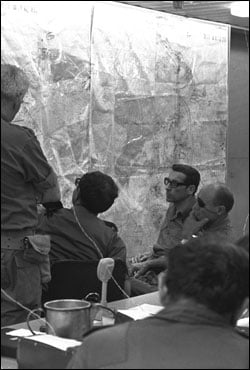
Artillery pieces grew from 802 to 1,100 within a week, and GeneralMoshe Dayan said, "You can get a stroke just from the numbers." Yet the Israelis continued to believe that war was not imminent.
In fact, the Israelis sent a message to the Egyptians and the Syrians through the Americans saying that Israel had no intention of carrying out hostile action against them.
They continued to overlook the signs of war, even as the Egyptians told their soldiers to break their Ramadan fast and deployed more boats to the Egyptian side of the Suez Canal, and the Syrians transferred more ammunition to a central depot on the Golan front.
The Holiest Day of the Year
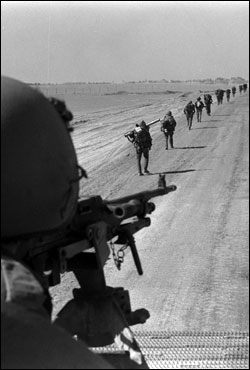
By that time Israeli intelligence was already fully aware of what was about to happen, and predicted that the war would begin the next day at around 6 p.m.
Many on the front line had a strong premonition that war would likely break out tomorrow. One general pushed off his departure from the front line and told the base rabbi to remain because "tomorrow there is going to be war."
This knowledge, however, was all but ignored by the decision makers. While the military men on the ground felt that an immediate deployment of all reserves was crucial, Defense Minister Moshe Dayan refused to deploy the entire combat reserve, agreeing only to 50,000-60,000 men.
Early on the morning of Yom Kippur, word of the definite impending war trickled from commanders to generals. By 6 a.m., it was the opinion of most in the ranks of the army that there was immediate need for a preemptive air strike. In a meeting with the prime minister, General David Elazar argued for a preemptive air strike against the Syrian airfields, and another, a few hours later, against their ground forces. To the general, the Syrian threat was much stronger because it was closer to Israeli towns where there were civilians who needed protection.
The general turned to the prime minister, who was by then a grandmother herself, with a passionate plea: "A preemptive strike would save many lives!"
The prime minister thought for a few moments and announced unequivocally that there would be no preemptive strike.
Later that afternoon, as millions prayed in synagogues, the Egyptian and Syrian armies surprised the Israelis – four hours earlier then predicted – with attacks on two fronts. Only then were all the reservists called up for deployment.
On the west bank of the Suez Canal, the Egyptians had 100,000 soldiers, 1,350 tanks, and 2,000 artillery pieces with heavy mortars. On the Israeli side there were 450 soldiers with 44 artillery pieces. A meager 220 Israeli tanks were spread out along 100 miles of the Sinai desert.
In the Golan Heights there were eight Syrian tanks for every Israeli tank. In addition to the major discrepancy between the number of Israeli and Syrian forces, the Syrians were also well prepared with secondary defense lines.
The next three days were horrible for the Israelis. Gone was the Israeli pride that had been shared by all after the triumph of the Six Day War. Hundreds of soldiers were killed, and many were taken into captivity. The Arab nations rejoiced—the Israeli army was proven not to be invincible after all. The soldiers' spirits were broken as they lost on many fronts.
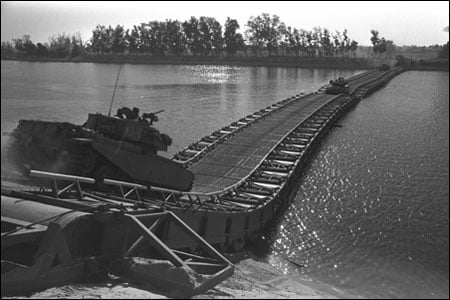
Over the following twelve days, the Israelis made advances, but only with great sacrifices. By the time the war ended with Israel declaring a military victory, they had lost 2,527 soldiers. The wounded numbered 7,251, and an additional 440 soldiers were in captivity.
A Call from Brooklyn
For years Israelis had known that there was a sage in Brooklyn who, in the words of General Ariel Sharon,1 was "interested and well versed" in the Israeli military and "deeply worried" about the situation in Israel. The Rebbe's approach was that fierce preemptive military action was needed to save lives, combined with heightened spiritual activity to beseech G‑d's mercy in minimizing the loss of life and injuries.
In fact for several years before the war the Rebbe called on Israel to fortify its borders with Arab nations, warning numerous times that the Bar-Lev Line was a disaster. "He considered [it] a disaster," writes Sharon in his autobiography, "an outmoded Maginot-like concept which could not be effective 'in our time of jets and airmobile forces.'"
Months before all the events described above, on July 12, 1973, the then formerpresident of Israel, Zalman Shazar, arrived at Lubavitch World Headquarters for a Chassidic gathering, known as a farbrengen. The Rebbe, of righteous memory, had recently begun a passionate campaign encouraging parents to teach their children additional Torah during the summer months, citing the verse from Psalms (8:3), "Out of the mouths of babes and sucklings You have established strength because of Your adversaries, in order to put an end to the enemy and avenger."
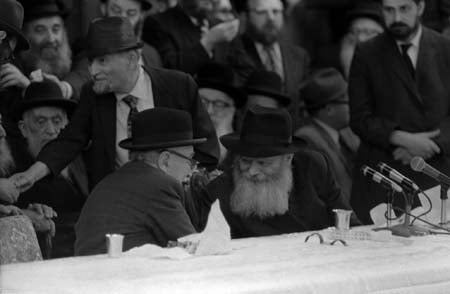
Following the farbrengen, which included scholarly talks, words of inspiration, and the singing of Chassidic melodies, Shazar entered the Rebbe's office.
Not much is known of their discussion, however Shazar did share this: When the Rebbe encouraged the extra Torah learning for children, he had in mind a specific danger that was hovering over the land of Israel. To Shazar it seemed strange—there was no forecast of immediate danger; on the contrary everything seemed to be calm in Israel.
"What all of a sudden happened?" Shazar asked the Rebbe.
The Rebbe did not respond. "He looked at me with a very serious look and tears began to flow from his eyes," Shazar said.
The Rebbe continued his campaign to increase children's Torah learning and prayer throughout the summer.
Children Gather
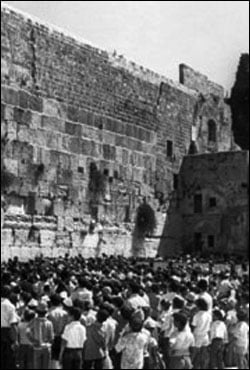
Three days later, on Monday, the paper reported that an "impressive gathering of thousands took place yesterday... The children arrived at the Western Wall in tens of buses, trains, trucks and private cars. With precise organization, the children filled the plaza before the Wall and the paths to the Wall, to capacity."
Four Torah verses selected by the Rebbe were recited at the rally. Every child received two coins of 10 Agurot, one as a gift from the Rebbe, with the suggestion to give it to charity, and another with the request to give it to charity. "Bank of Israel prepared tens of thousands of shiny new coins for the occasion, amounting to several thousand Lirot," reported the paper.
The "heartfelt event" was over within twenty minutes and the crowd dispersed.
Similar gatherings took place across the globe.
Four days before Yom Kippur, the Rebbe called for a gathering of children at Lubavitch World Headquarters, where he personally gave every child two coins to be given to charity.
"I Did Not Know"
Throughout Yom Kippur the Rebbe’s mood was somber, regulars at the prayer services pointed out the crying and tears rolling down the Rebbe’s cheeks. At times during the prayers he cried bitterly over the fate of lives at stake in Israel.
Three days after the war began, there was another Chassidic gathering at Lubavitch World Headquarters, this time to honor the anniversary of the passing of Rabbi Shmuel, the fourth Chabad Rebbe. At the gathering the Rebbe also touched on the war in the Middle East. He said that at this time the most important thing is to keep the morale high and to serve G‑d with happiness. The Rebbe quoted the sages that, "happiness breaks all boundaries."
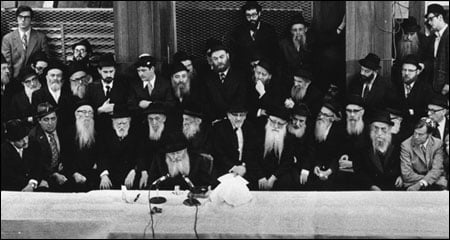
At this time, Israelis were scratching their heads about how the Rebbe had known of the impending war. "How did the Rebbe know?" asked Yediot Ahronot. The Rebbe also turned to this very issue at the gathering (paraphrased here from the original Yiddish):
"There are things that are done, however, at the time we do not know what the goal of these activities are; only later on do we realize the reason.
"I do not know why all of a sudden there was a call to gather the children in prayer and charity, it only seemed that at the time there was a need, 'to put an end to the enemy and avenger.'"
The Lessons
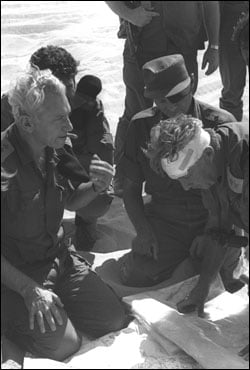
Tens of thousands began to call for the dismantling of the current government. Israelis believed that since there had been knowledge of the oncoming war, preemptive action would have greatly minimized the amount of Israeli casualties. This was also the belief of the military generals who were baffled by the politicians' decisions.
A short while later, in February, the prime minister and the minister of defense both resigned their posts.
Immediately following the war, Chabad in Israel sprung into action, spearheading a mammoth effort to assist the widows and orphans of the Israeli soldiers killed in action. The Rebbe wrote lengthy letters to many of the widows and the broken-spirited soldiers who were wounded in combat, lauding their great sacrifice for the nation of Israel. The Rebbe also penned warm letters to IDF generals and encouraged his followers to assist in boosting the morale amongst the troops.
Mourning the unnecessary loss of life, the Rebbe continuously urged Israeli politicians, in public addresses and in private audiences, to learn from the errors of the war.
On November 5, 1973, the Rebbe, writing to an educator regarding the importance of Jewish education in order to prevent assimilation, learnt a lesson from what occurred during the summer before the war:
Now it is quite evident how important and urgent has been the appeal made in the latter part of this summer, centered on מפי עוללים ויונקים גו' (כדי) להשבית אויב ומתנקם [Out of the mouths of babes and sucklings etc. (in order) to counter Your enemies, to silence the enemy and avenger (Psalms 8:3)].
The above, incidentally, conveys a basic lesson, which becomes more obvious by analogy from medicine, which has two general aspects: cure and prevention. The first has to do with curing the sick; the second—with preventing sickness. At first glance, the accomplishment of the physician in curing the sick seems more impressive by its dramatic results than preventive medicine, where there could be some delusion that sickness would be somehow avoided. In truth, however, it is surely better to be certain of immunity to sickness. The latter is the way of G‑d, as it is written: כל המחלה גו' לא אשים עליך כי אני ה' רופאך [All the sicknesses etc. I will not visit upon you, for I, the G-d, heal you (Exodus 15:26)]
Despite human errors during the war, there was a miraculous victory, as the Rebbe described in a letter after the war:
…there were ample miracles, and quite obvious ones, in the last war. The overall miracle, which has now been revealed, although not overly publicized, is the survival after the first few days of the war, when even Washington was seriously concerned whether the Israeli army could halt the tremendous onslaught of the first attack. Slowly and gradually some details are now being revealed also in the Israeli press as to how serious was the danger in those early days of the war.
The greatest miracle was that the Egyptians stopped their invasion for no good reason only a few miles east of the Canal. The obvious military strategy would have been to leave a few fortified positions in the rear, and with the huge army of 100,000 men armed to the teeth, to march forward in Sinai, where at that point in time there was no organized defense of any military consequence. This is something that cannot be explained in the natural order of things, except as it is written, “The dread of the Jews fell upon them,” in the face of their intelligence reports about the complete unpreparedness of the Jews in Eretz Yisrael [the land of Israel] at that time.
Sources: The Yom Kippur War by Abraham Rabinovich (Schoken 2004), Yisroel 50 (Maariv 1998), Igrot Kodesh vol. 28 (Kehot 2006), Yemei Tmimim (Tomchei Tmimim Lubavitch Lod, 2009) and Warrior by Ariel Sharon with David Chanoff (Simon and Schuster, 1989).